.

This image was taken by Mastcam: Right (MAST_RIGHT) onboard NASA's Mars rover Curiosity on Sol 370 (2013-08-21 05:51:35 UTC).
.

NASA's Mars rover Curiosity acquired this image using its Mars Hand Lens Imager (MAHLI), located on the turret at the end of the rover's robotic arm, on August 21, 2013, Sol 370 of the Mars Science Laboratory Mission, at 08:39:20 UTC.
When this image was obtained, the focus motor count position was 12552. This number indicates the internal position of the MAHLI lens at the time the image was acquired. This count also tells whether the dust cover was open or closed. Values between 0 and 6000 mean the dust cover was closed; values between 12500 and 16000 occur when the cover is open. For close-up images, the motor count can in some cases be used to estimate the distance between the MAHLI lens and target. For example, in-focus images obtained with the dust cover open for which the lens was 2.5 cm from the target have a motor count near 15270. If the lens is 5 cm from the target, the motor count is near 14360; if 7 cm, 13980; 10 cm, 13635; 15 cm, 13325; 20 cm, 13155; 25 cm, 13050; 30 cm, 12970. These correspond to image scales, in micrometers per pixel, of about 16, 25, 32, 42, 60, 77, 95, and 113.
Most images acquired by MAHLI in daylight use the sun as an illumination source. However, in some cases, MAHLI's two groups of white light LEDs and one group of longwave ultraviolet (UV) LEDs might be used to illuminate targets. When Curiosity acquired this image, the group 1 white light LEDs were off, the group 2 white light LEDs were off, and the ultraviolet (UV) LEDS were off.
.

This image was taken by Mastcam: Right (MAST_RIGHT) onboard NASA's Mars rover Curiosity on Sol 371 (2013-08-22 06:23:54 UTC).
.

This image was taken by Navcam: Left B (NAV_LEFT_B) onboard NASA's Mars rover Curiosity on Sol 371 (2013-08-22 10:31:58 UTC).
.

This image was taken by Mastcam: Left (MAST_LEFT) onboard NASA's Mars rover Curiosity on Sol 372 (2013-08-23 06:47:03 UTC).
.

NASA's Mars rover Curiosity acquired this image using its Mars Hand Lens Imager (MAHLI), located on the turret at the end of the rover's robotic arm, on August 23, 2013, Sol 372 of the Mars Science Laboratory Mission, at 07:17:11 UTC.
When this image was obtained, the focus motor count position was 12552. This number indicates the internal position of the MAHLI lens at the time the image was acquired. This count also tells whether the dust cover was open or closed. Values between 0 and 6000 mean the dust cover was closed; values between 12500 and 16000 occur when the cover is open. For close-up images, the motor count can in some cases be used to estimate the distance between the MAHLI lens and target. For example, in-focus images obtained with the dust cover open for which the lens was 2.5 cm from the target have a motor count near 15270. If the lens is 5 cm from the target, the motor count is near 14360; if 7 cm, 13980; 10 cm, 13635; 15 cm, 13325; 20 cm, 13155; 25 cm, 13050; 30 cm, 12970. These correspond to image scales, in micrometers per pixel, of about 16, 25, 32, 42, 60, 77, 95, and 113.
Most images acquired by MAHLI in daylight use the sun as an illumination source. However, in some cases, MAHLI's two groups of white light LEDs and one group of longwave ultraviolet (UV) LEDs might be used to illuminate targets. When Curiosity acquired this image, the group 1 white light LEDs were off, the group 2 white light LEDs were off, and the ultraviolet (UV) LEDS were off.
.
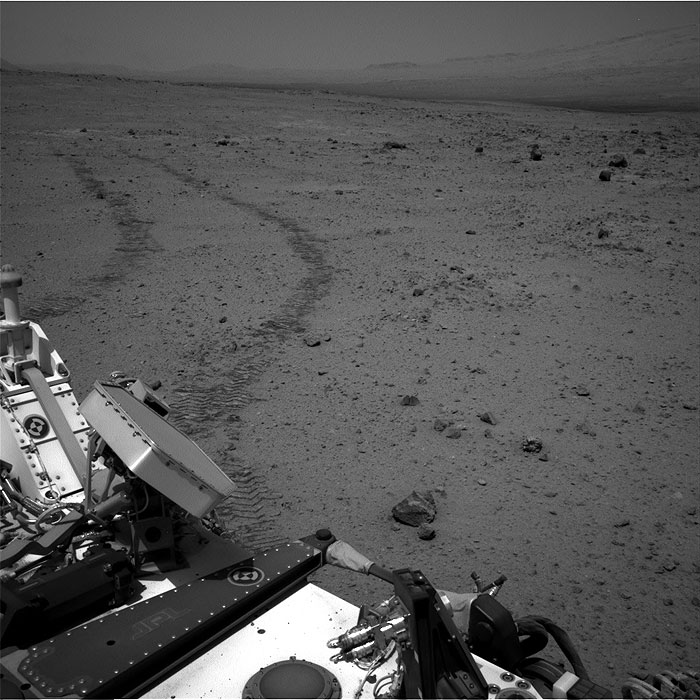
This image was taken by Navcam: Right B (NAV_RIGHT_B) onboard NASA's Mars rover Curiosity on Sol 372 (2013-08-23 09:43:30 UTC).
.

This image was taken by Mastcam: Right (MAST_RIGHT) onboard NASA's Mars rover Curiosity on Sol 373 (2013-08-24 11:08:43 UTC).
.
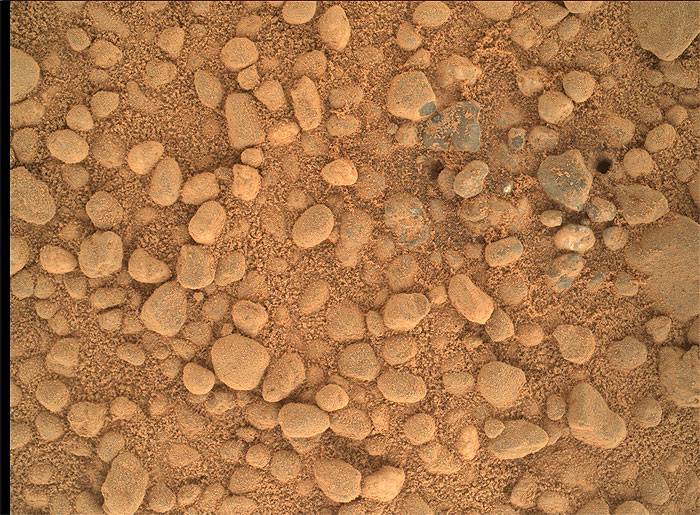
NASA's Mars rover Curiosity acquired this image using its Mars Hand Lens Imager (MAHLI), located on the turret at the end of the rover's robotic arm, on August 24, 2013, Sol 373 of the Mars Science Laboratory Mission, at 09:21:41 UTC.
When this image was obtained, the focus motor count position was 14056. This number indicates the internal position of the MAHLI lens at the time the image was acquired. This count also tells whether the dust cover was open or closed. Values between 0 and 6000 mean the dust cover was closed; values between 12500 and 16000 occur when the cover is open. For close-up images, the motor count can in some cases be used to estimate the distance between the MAHLI lens and target. For example, in-focus images obtained with the dust cover open for which the lens was 2.5 cm from the target have a motor count near 15270. If the lens is 5 cm from the target, the motor count is near 14360; if 7 cm, 13980; 10 cm, 13635; 15 cm, 13325; 20 cm, 13155; 25 cm, 13050; 30 cm, 12970. These correspond to image scales, in micrometers per pixel, of about 16, 25, 32, 42, 60, 77, 95, and 113.
Most images acquired by MAHLI in daylight use the sun as an illumination source. However, in some cases, MAHLI's two groups of white light LEDs and one group of longwave ultraviolet (UV) LEDs might be used to illuminate targets. When Curiosity acquired this image, the group 1 white light LEDs were off, the group 2 white light LEDs were off, and the ultraviolet (UV) LEDS were off.
.

This image was taken by Rear Hazcam: Left B (RHAZ_LEFT_B) onboard NASA's Mars rover Curiosity on Sol 373 (2013-08-24 06:54:34 UTC).
.

This image was taken by Mastcam: Left (MAST_LEFT) onboard NASA's Mars rover Curiosity on Sol 374 (2013-08-25 11:28:26 UTC).
.

NASA's Mars rover Curiosity acquired this image using its Mars Hand Lens Imager (MAHLI), located on the turret at the end of the rover's robotic arm, on August 25, 2013, Sol 374 of the Mars Science Laboratory Mission, at 10:02:46 UTC.
When this image was obtained, the focus motor count position was 12552. This number indicates the internal position of the MAHLI lens at the time the image was acquired. This count also tells whether the dust cover was open or closed. Values between 0 and 6000 mean the dust cover was closed; values between 12500 and 16000 occur when the cover is open. For close-up images, the motor count can in some cases be used to estimate the distance between the MAHLI lens and target. For example, in-focus images obtained with the dust cover open for which the lens was 2.5 cm from the target have a motor count near 15270. If the lens is 5 cm from the target, the motor count is near 14360; if 7 cm, 13980; 10 cm, 13635; 15 cm, 13325; 20 cm, 13155; 25 cm, 13050; 30 cm, 12970. These correspond to image scales, in micrometers per pixel, of about 16, 25, 32, 42, 60, 77, 95, and 113.
Most images acquired by MAHLI in daylight use the sun as an illumination source. However, in some cases, MAHLI's two groups of white light LEDs and one group of longwave ultraviolet (UV) LEDs might be used to illuminate targets. When Curiosity acquired this image, the group 1 white light LEDs were off, the group 2 white light LEDs were off, and the ultraviolet (UV) LEDS were off.
-

This image was taken by Navcam: Right B (NAV_RIGHT_B) onboard NASA's Mars rover Curiosity on Sol 374 (2013-08-25 09:12:57 UTC).
.

This image was taken by Mastcam: Left (MAST_LEFT) onboard NASA's Mars rover Curiosity on Sol 375 (2013-08-26 08:16:44 UTC).
.

This image was taken by Mastcam: Left (MAST_LEFT) onboard NASA's Mars rover Curiosity on Sol 375 (2013-08-26 08:21:32 UTC).
.

This image was taken by Mastcam: Left (MAST_LEFT) onboard NASA's Mars rover Curiosity on Sol 375 (2013-08-26 08:28:59 UTC).
.

This image was taken by Mastcam: Left (MAST_LEFT) onboard NASA's Mars rover Curiosity on Sol 375 (2013-08-26 08:41:30 UTC).
.
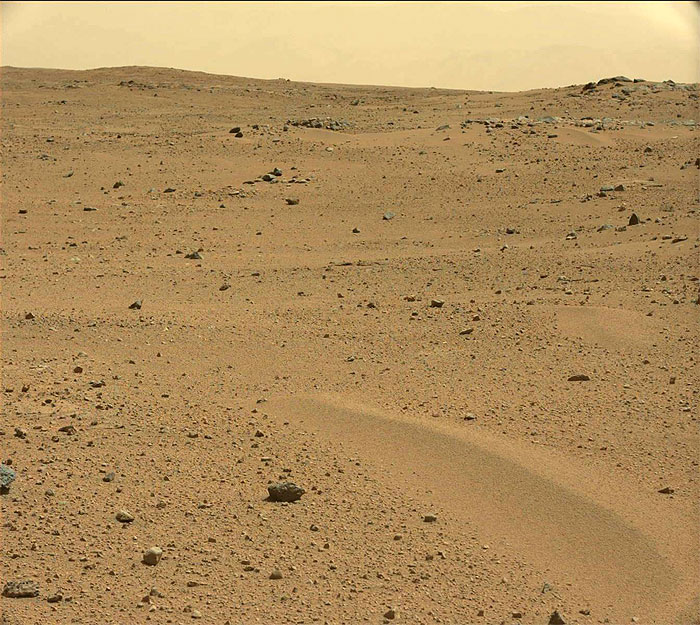
This image was taken by Mastcam: Left (MAST_LEFT) onboard NASA's Mars rover Curiosity on Sol 376 (2013-08-27 12:34:19 UTC).
.
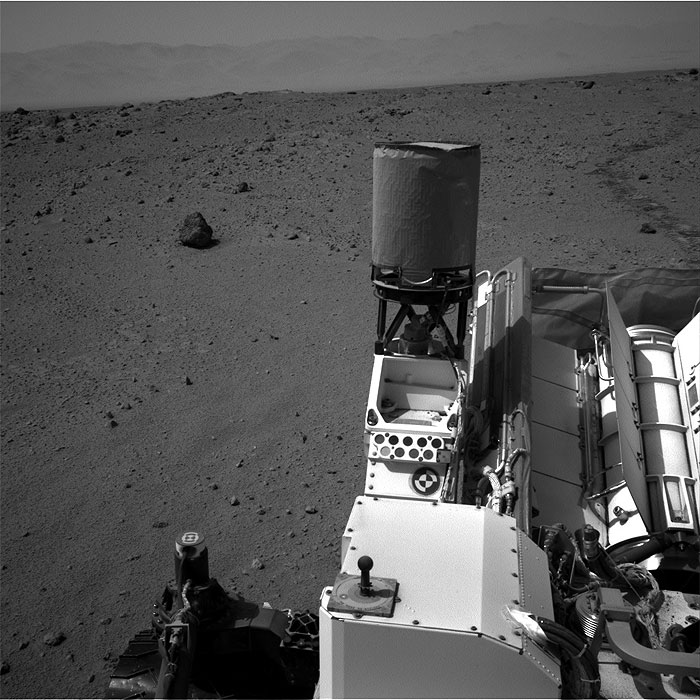
This image was taken by Navcam: Right B (NAV_RIGHT_B) onboard NASA's Mars rover Curiosity on Sol 376 (2013-08-27 12:36:12 UTC).
.
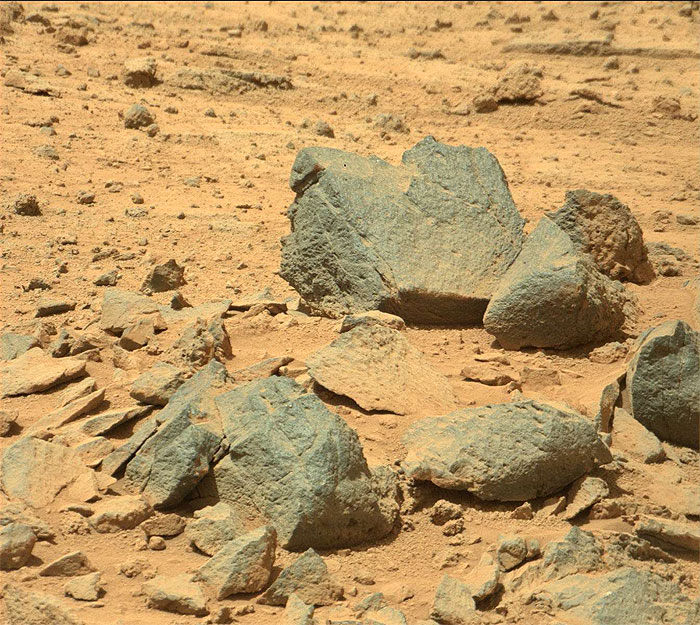
This image was taken by Mastcam: Right (MAST_RIGHT) onboard NASA's Mars rover Curiosity on Sol 377 (2013-08-28 10:02:55 UTC).
.

This image was taken by Mastcam: Right (MAST_RIGHT) onboard NASA's Mars rover Curiosity on Sol 377 (2013-08-28 10:08:18 UTC).
.

This image was taken by Mastcam: Right (MAST_RIGHT) onboard NASA's Mars rover Curiosity on Sol 378 (2013-08-29 02:30:18 UTC).
.
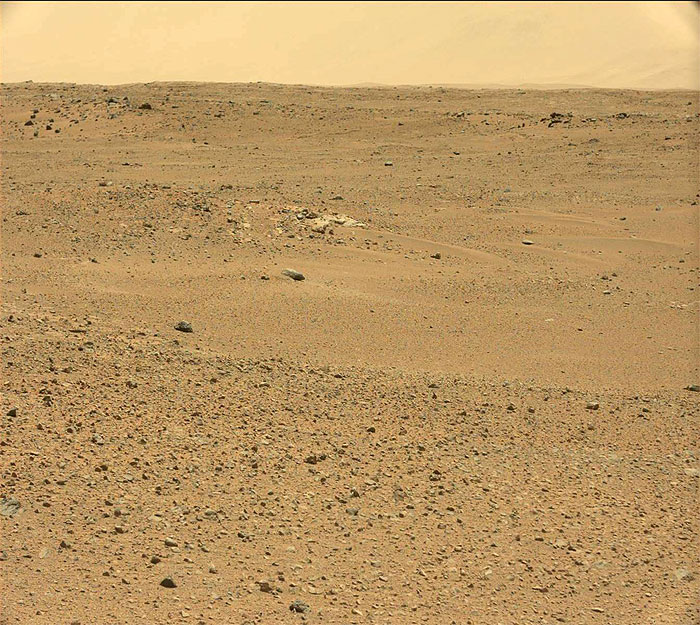
This image was taken by Mastcam: Left (MAST_LEFT) onboard NASA's Mars rover Curiosity on Sol 378 (2013-08-29 13:02:12 UTC).
.

This image was taken by Navcam: Right B (NAV_RIGHT_B) onboard NASA's Mars rover Curiosity on Sol 378 (2013-08-29 13:17:41 UTC).
.

This image was taken by Rear Hazcam: Left B (RHAZ_LEFT_B) onboard NASA's Mars rover Curiosity on Sol 378 (2013-08-29 12:10:50 UTC).
.

NASA's Mars rover Curiosity acquired this image using its Mars Hand Lens Imager (MAHLI), located on the turret at the end of the rover's robotic arm, on August 30, 2013, Sol 379 of the Mars Science Laboratory Mission, at 13:23:46 UTC.
When this image was obtained, the focus motor count position was 12552. This number indicates the internal position of the MAHLI lens at the time the image was acquired. This count also tells whether the dust cover was open or closed. Values between 0 and 6000 mean the dust cover was closed; values between 12500 and 16000 occur when the cover is open. For close-up images, the motor count can in some cases be used to estimate the distance between the MAHLI lens and target. For example, in-focus images obtained with the dust cover open for which the lens was 2.5 cm from the target have a motor count near 15270. If the lens is 5 cm from the target, the motor count is near 14360; if 7 cm, 13980; 10 cm, 13635; 15 cm, 13325; 20 cm, 13155; 25 cm, 13050; 30 cm, 12970. These correspond to image scales, in micrometers per pixel, of about 16, 25, 32, 42, 60, 77, 95, and 113.
Most images acquired by MAHLI in daylight use the sun as an illumination source. However, in some cases, MAHLI's two groups of white light LEDs and one group of longwave ultraviolet (UV) LEDs might be used to illuminate targets. When Curiosity acquired this image, the group 1 white light LEDs were off, the group 2 white light LEDs were off, and the ultraviolet (UV) LEDS were off.
.

This image was taken by Navcam: Right B (NAV_RIGHT_B) onboard NASA's Mars rover Curiosity on Sol 379 (2013-08-30 13:33:57 UTC).
.

This image was taken by Mastcam: Right (MAST_RIGHT) onboard NASA's Mars rover Curiosity on Sol 382 (2013-09-02 13:48:42 UTC).
.

This image was taken by Mastcam: Left (MAST_LEFT) onboard NASA's Mars rover Curiosity on Sol 383 (2013-09-03 20:26:19 UTC).
.

This image was taken by Navcam: Right B (NAV_RIGHT_B) onboard NASA's Mars rover Curiosity on Sol 383 (2013-09-03 20:26:53 UTC).
.

This image was taken by Mastcam: Right (MAST_RIGHT) onboard NASA's Mars rover Curiosity on Sol 385 (2013-09-05 06:32:15 UTC).
.

This image was taken by Mastcam: Right (MAST_RIGHT) onboard NASA's Mars rover Curiosity on Sol 385 (2013-09-05 14:53:25 UTC).
.

This image was taken by Mastcam: Left (MAST_LEFT) onboard NASA's Mars rover Curiosity on Sol 385 (2013-09-05 20:31:59 UTC).
.
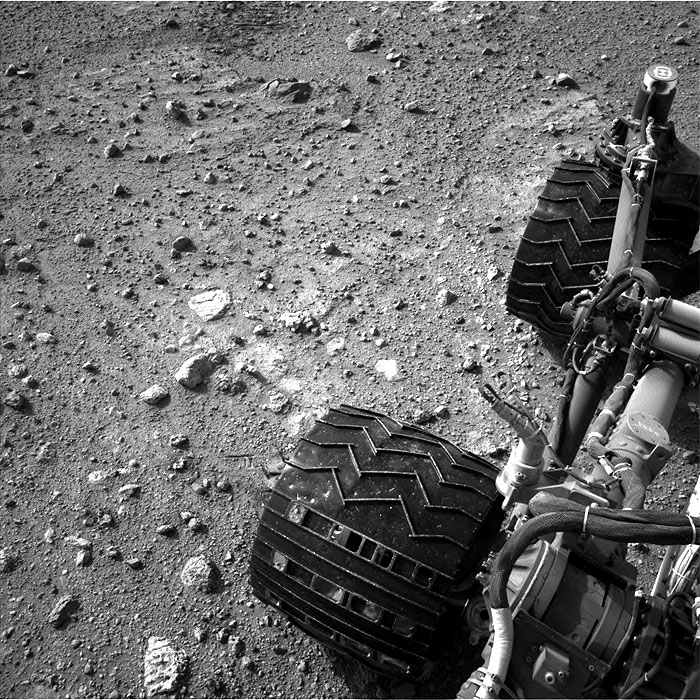
This image was taken by Navcam: Left B (NAV_LEFT_B) onboard NASA's Mars rover Curiosity on Sol 385 (2013-09-05 20:40:21 UTC).
.

NASA's Mars rover Curiosity acquired this image using its Mars Hand Lens Imager (MAHLI), located on the turret at the end of the rover's robotic arm, on September 7, 2013, Sol 387 of the Mars Science Laboratory Mission, at 23:50:18 UTC.
When this image was obtained, the focus motor count position was 14634. This number indicates the internal position of the MAHLI lens at the time the image was acquired. This count also tells whether the dust cover was open or closed. Values between 0 and 6000 mean the dust cover was closed; values between 12500 and 16000 occur when the cover is open. For close-up images, the motor count can in some cases be used to estimate the distance between the MAHLI lens and target. For example, in-focus images obtained with the dust cover open for which the lens was 2.5 cm from the target have a motor count near 15270. If the lens is 5 cm from the target, the motor count is near 14360; if 7 cm, 13980; 10 cm, 13635; 15 cm, 13325; 20 cm, 13155; 25 cm, 13050; 30 cm, 12970. These correspond to image scales, in micrometers per pixel, of about 16, 25, 32, 42, 60, 77, 95, and 113.
Most images acquired by MAHLI in daylight use the sun as an illumination source. However, in some cases, MAHLI's two groups of white light LEDs and one group of longwave ultraviolet (UV) LEDs might be used to illuminate targets. When Curiosity acquired this image, the group 1 white light LEDs were off, the group 2 white light LEDs were off, and the ultraviolet (UV) LEDS were off.
.

NASA's Mars rover Curiosity acquired this image using its Mars Hand Lens Imager (MAHLI), located on the turret at the end of the rover's robotic arm, on September 8, 2013, Sol 387 of the Mars Science Laboratory Mission, at 00:02:17 UTC.
When this image was obtained, the focus motor count position was 14094. This number indicates the internal position of the MAHLI lens at the time the image was acquired. This count also tells whether the dust cover was open or closed. Values between 0 and 6000 mean the dust cover was closed; values between 12500 and 16000 occur when the cover is open. For close-up images, the motor count can in some cases be used to estimate the distance between the MAHLI lens and target. For example, in-focus images obtained with the dust cover open for which the lens was 2.5 cm from the target have a motor count near 15270. If the lens is 5 cm from the target, the motor count is near 14360; if 7 cm, 13980; 10 cm, 13635; 15 cm, 13325; 20 cm, 13155; 25 cm, 13050; 30 cm, 12970. These correspond to image scales, in micrometers per pixel, of about 16, 25, 32, 42, 60, 77, 95, and 113.
Most images acquired by MAHLI in daylight use the sun as an illumination source. However, in some cases, MAHLI's two groups of white light LEDs and one group of longwave ultraviolet (UV) LEDs might be used to illuminate targets. When Curiosity acquired this image, the group 1 white light LEDs were off, the group 2 white light LEDs were off, and the ultraviolet (UV) LEDS were off.
.

This image was taken by Mastcam: Right (MAST_RIGHT) onboard NASA's Mars rover Curiosity on Sol 388 (2013-09-08 23:01:00 UTC).
.

This image was taken by Mastcam: Right (MAST_RIGHT) onboard NASA's Mars rover Curiosity on Sol 388 (2013-09-08 23:10:58 UTC).
.
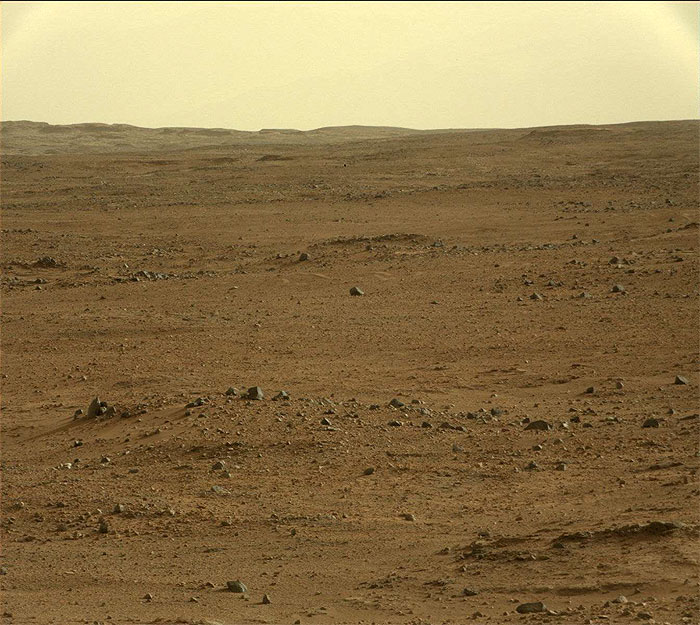
This image was taken by Mastcam: Right (MAST_RIGHT) onboard NASA's Mars rover Curiosity on Sol 388 (2013-09-08 23:12:00 UTC).
.

This image was taken by Mastcam: Right (MAST_RIGHT) onboard NASA's Mars rover Curiosity on Sol 388 (2013-09-08 23:22:58 UTC).
.
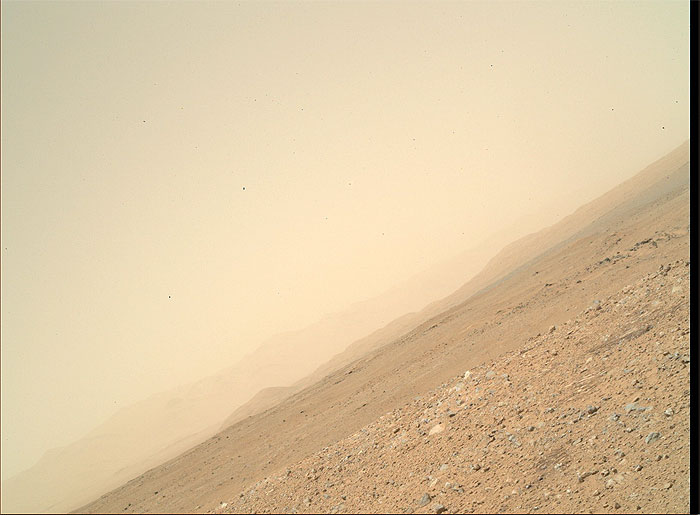
NASA's Mars rover Curiosity acquired this image using its Mars Hand Lens Imager (MAHLI), located on the turret at the end of the rover's robotic arm, on September 8, 2013, Sol 388 of the Mars Science Laboratory Mission, at 19:07:26 UTC.
When this image was obtained, the focus motor count position was 12552. This number indicates the internal position of the MAHLI lens at the time the image was acquired. This count also tells whether the dust cover was open or closed. Values between 0 and 6000 mean the dust cover was closed; values between 12500 and 16000 occur when the cover is open. For close-up images, the motor count can in some cases be used to estimate the distance between the MAHLI lens and target. For example, in-focus images obtained with the dust cover open for which the lens was 2.5 cm from the target have a motor count near 15270. If the lens is 5 cm from the target, the motor count is near 14360; if 7 cm, 13980; 10 cm, 13635; 15 cm, 13325; 20 cm, 13155; 25 cm, 13050; 30 cm, 12970. These correspond to image scales, in micrometers per pixel, of about 16, 25, 32, 42, 60, 77, 95, and 113.
Most images acquired by MAHLI in daylight use the sun as an illumination source. However, in some cases, MAHLI's two groups of white light LEDs and one group of longwave ultraviolet (UV) LEDs might be used to illuminate targets. When Curiosity acquired this image, the group 1 white light LEDs were off, the group 2 white light LEDs were off, and the ultraviolet (UV) LEDS were off.
.

This image was taken by Navcam: Left B (NAV_LEFT_B) onboard NASA's Mars rover Curiosity on Sol 388 (2013-09-08 22:55:32 UTC).
.

This image was taken by Front Hazcam: Right B (FHAZ_RIGHT_B) onboard NASA's Mars rover Curiosity on Sol 388 (2013-09-08 22:45:58 UTC).
.
Fotos: NASA
.
NASA's Mars rover Curiosity now has a view of a patch of exposed bedrock scientists selected for a few days of close-up study, the first such study since the rover began its long trek to Mount Sharp two months ago.
Curiosity reached the crest of a rise informally called "Panorama Point." From Panorama Point, the rover took photographs of a pale-toned outcrop area that the team chose earlier as "Waypoint 1" on the basis of imagery from NASA's Mars Reconnaissance Orbiter.
Five selected waypoints dot the mission's route southwestward from the "Glenelg" area, where Curiosity worked during the first half of 2013, and an entry point to the lower layers of Mount Sharp, the mission's next major destination. Waypoint 1 lies about one-fifth of the way along the approximately 5.3-mile (8.6-kilometer) route, as plotted from examining orbiter images.
Curiosity advanced 464 feet (141.5 meters) on Sept. 5 in the longest one-day drive so far in the 13-month-old mission. The drive toward the elevated Panorama Point combined two segments. For a long initial segment, engineers chose the path from images examined on Earth ahead of time. That was followed by a 138-foot (42-meter) segment, for which the rover autonomously navigated its own path based on images taken during the day's drive. That Sept. 5 drive plus the next one -- 80 feet (24.3 meters) on Sept. 8 -- brought the rover to the top of Panorama Point.
For the Sept. 5 drive, "we had a long and unobstructed view of the hill we needed to climb, which would provide an overlook of the first major waypoint on our trek to Mount Sharp," said Jeff Biesiadecki, a rover planner on the Curiosity team at NASA's Jet Propulsion Laboratory, Pasadena, Calif. "We were able to extend the drive well beyond what we could see by enabling the rover's onboard hazard avoidance system."
In the Glenelg area, Curiosity accomplished the mission's major science goal by finding evidence of an ancient environment favorable for microbial life. The evidence came from analysis of rock powder drilled from two outcrops in a shallow depression called "Yellowknife Bay." When the rover examines multiple rock layers of Mount Sharp, researchers hope to learn more about ancient habitable environments and major changes in environmental conditions.
"We want to know how the rocks at Yellowknife Bay are related to what we'll see at Mount Sharp," said the mission's project scientist, John Grotzinger of the California Institute of Technology, Pasadena. "That's what we intend to get from the waypoints between them. We'll use them to stitch together a timeline -- which layers are older, which are younger."
The science team is using images taken from Panorama Point to select precisely where to pause for a few days and use instruments on Curiosity's arm to examine Waypoint 1. The rock targets being considered are still about 245 feet (75 meters) southwest of Curiosity's Sept. 9 position.
The trek to Mount Sharp will continue for many months after the planned work at Waypoint 1.
NASA's Jet Propulsion Laboratory, a division of Caltech in Pasadena, manages the Mars Science Laboratory Project for NASA's Science Mission Directorate, Washington. JPL designed and built the project's Curiosity rover.
Quelle: NASA
5213 Views
